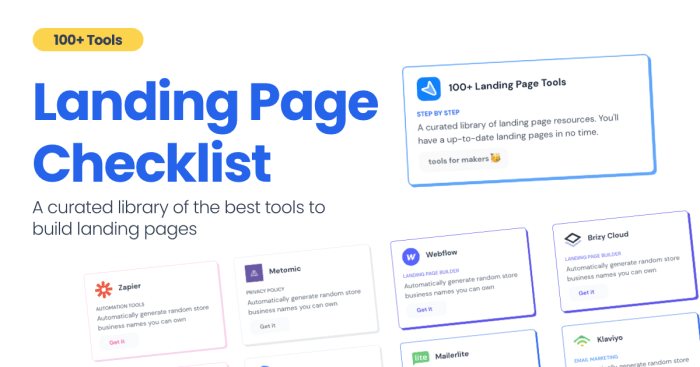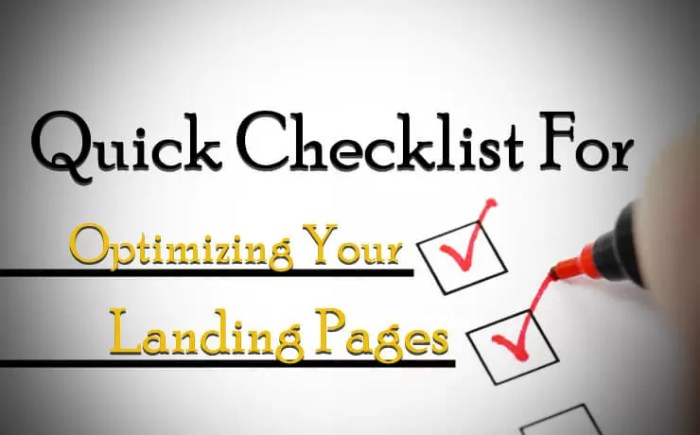Creating a Landing Page Optimization Checklist sets the stage for enhancing your website’s performance and user experience. Dive into the essential components and best practices to optimize your landing page effectively.
Learn how to test, iterate, and measure the impact of your checklist implementation for maximum results. Discover the top tools to streamline the process and elevate your online presence.
Importance of Landing Page Optimization Checklist: Creating A Landing Page Optimization Checklist
Having a landing page optimization checklist is like having a map to guide you through a maze of website elements. It helps you ensure that your landing page is optimized to its full potential, maximizing conversions and user experience.Using a checklist for landing page optimization comes with a plethora of benefits. It helps you stay organized, ensuring that no crucial elements are overlooked.
It also acts as a reference point to track progress and make necessary adjustments along the way. By following a checklist, you can systematically analyze and improve various aspects of your landing page, leading to better performance and results.
Enhanced User Experience
- Ensures that the landing page is user-friendly and easy to navigate.
- Helps in identifying and fixing any usability issues that may hinder user interaction.
- Optimizes page load speed for a seamless browsing experience.
Increased Conversion Rates
- Focuses on strategic placement of call-to-action buttons for maximum impact.
- Tests and refines elements like headline, images, and forms to boost conversion rates.
- Utilizes A/B testing to determine the most effective design and content combinations.
Components of a Comprehensive Landing Page Optimization Checklist
In order to create a successful landing page, it is essential to have a comprehensive optimization checklist that covers all the key elements. Each component plays a crucial role in ensuring that your landing page is effective in converting visitors into leads or customers.
Clear and Compelling Headline
A clear and compelling headline is the first thing visitors see when they land on your page. It should be attention-grabbing, relevant to the offer, and convey the value proposition of your product or service.
Engaging Visuals
Visual elements such as images, videos, and infographics can help capture the attention of visitors and communicate information more effectively than text alone. High-quality visuals can also enhance the overall aesthetic appeal of your landing page.
Strong Call-to-Action (CTA)
A strong call-to-action is crucial for guiding visitors towards the desired action, whether it’s making a purchase, signing up for a newsletter, or downloading a resource. The CTA should be clear, prominently displayed, and use persuasive language to encourage conversions.
Hey there, have you ever wondered about different Project Management Techniques used in the business world? From Agile to Waterfall, these strategies help keep projects on track and organized. Understanding these techniques can really give you an edge in the competitive job market!
Mobile Responsiveness
With the increasing use of mobile devices, it is essential for your landing page to be optimized for mobile responsiveness. This ensures that visitors have a seamless experience regardless of the device they are using, leading to higher conversion rates.
Social Proof and Testimonials
Including social proof such as customer testimonials, reviews, or endorsements can help build credibility and trust with visitors. Positive feedback from satisfied customers can reassure potential leads and encourage them to take action.
Performance Tracking and Analytics
Monitoring the performance of your landing page through analytics tools is essential for measuring the effectiveness of your optimization efforts. Tracking key metrics such as conversion rates, bounce rates, and click-through rates can help identify areas for improvement and optimize for better results.
Hey yo, if you’re looking to level up your game in handling projects, you gotta check out some dope Project Management Techniques. These techniques will have you running projects like a boss, keeping things on track and making sure you hit those deadlines. Don’t sleep on this, fam!
Best Practices for Creating a Landing Page Optimization Checklist

When it comes to crafting a successful landing page optimization checklist, there are a few key best practices to keep in mind. These practices can help you structure and organize your checklist effectively, ensuring that you cover all the necessary components for maximum impact.
Tips for Structuring and Organizing Your Checklist
- Start with clear objectives: Define the goals and objectives you want to achieve with your landing page optimization efforts. This will help guide the rest of your checklist.
- Break it down into sections: Organize your checklist into sections based on different aspects of landing page optimization, such as design, copywriting, and call-to-action.
- Include actionable steps: Each item on your checklist should be actionable, with specific tasks that need to be completed to optimize your landing page effectively.
- Prioritize tasks: Rank the items on your checklist in order of importance, so you know which tasks to focus on first for the best results.
Examples of Successful Landing Page Optimization Checklists
| Checklist Title | Key Features | Source |
|---|---|---|
| Conversion-Centered Design Checklist | Focuses on design elements that drive conversions, such as attention-grabbing headlines and compelling visuals. | ConversionXL |
| -Optimized Landing Page Checklist | Includes steps for optimizing landing pages for search engines, such as research and meta tags. | HubSpot |
| Mobile-Friendly Checklist | Ensures that landing pages are optimized for mobile devices, with responsive design and fast loading times. | Neil Patel |
Testing and Iterating Checklist Items
Testing and iterating checklist items is crucial in the process of optimizing a landing page. By testing each checklist item for effectiveness, you can gather valuable data to understand what works best for your audience and what needs improvement. This iterative approach allows you to refine your checklist over time, ensuring that it continues to drive conversions and meet your goals.
Strategies for Iterating and Improving the Checklist
- Implement A/B testing: Create different versions of your landing page with variations in checklist items to see which performs better. Analyze the results to identify what elements are most effective in driving conversions.
- Collect feedback: Gather insights from users who have interacted with your landing page and checklist. Use this feedback to make informed decisions about which checklist items to adjust or remove.
- Monitor analytics: Keep track of key metrics such as bounce rate, conversion rate, and time on page to understand the impact of checklist changes. Use this data to guide your optimization efforts.
- Stay updated: Regularly review industry best practices and trends to ensure your checklist remains relevant and effective. Make adjustments based on new insights to continuously improve performance.
Tools for Implementing Landing Page Optimization Checklist

Implementing and tracking checklist items for landing page optimization can be made easier with the help of various tools available in the market. These tools can assist in analyzing data, conducting A/B tests, monitoring user behavior, and improving overall conversion rates.
Google Analytics
Google Analytics is a powerful tool that provides in-depth insights into website traffic, user behavior, and conversion rates. It can help track the performance of landing pages, identify areas for improvement, and measure the effectiveness of optimization efforts.
Optimizely
Optimizely is a popular A/B testing tool that allows users to create and run experiments on landing pages to determine which variations perform best. It provides a user-friendly interface for testing different elements such as headlines, images, and call-to-action buttons.
Hotjar
Hotjar is a tool that offers heatmaps, session recordings, and user surveys to understand how visitors interact with landing pages. It can help identify usability issues, optimize page layout, and improve overall user experience.
Crazy Egg
Crazy Egg is another tool that provides heatmaps, scrollmaps, and click reports to visualize user behavior on landing pages. It can help optimize page design, improve conversion rates, and make data-driven decisions based on user interactions.
Unbounce
Unbounce is a landing page builder that offers A/B testing, dynamic text replacement, and analytics integration to optimize conversion rates. It allows users to create custom landing pages, test different variations, and analyze performance data in real-time.
Visual Website Optimizer (VWO)
VWO is a comprehensive optimization platform that combines A/B testing, multivariate testing, and behavioral targeting to improve landing page performance. It offers advanced features for tracking visitor behavior, personalizing content, and increasing conversions.
Measuring the Impact of Checklist Implementation
Implementing a landing page optimization checklist is just the first step towards improving your conversion rates. To truly understand its effectiveness, you need to measure the impact of its implementation. Tracking key metrics can provide valuable insights into how well your checklist is performing and where improvements can be made.
Tracking Key Metrics, Creating a Landing Page Optimization Checklist
- Conversion Rate: Monitor changes in your conversion rate before and after implementing the checklist. A higher conversion rate indicates that your checklist is effective in guiding visitors towards the desired action.
- Bounce Rate: Analyze the bounce rate to see if visitors are engaging with your landing page or leaving immediately. A decrease in bounce rate suggests that the checklist is helping to retain visitors.
- Time on Page: Measure how much time visitors spend on your landing page. An increase in average time on page could indicate that the checklist is engaging and persuasive.
- Click-Through Rate (CTR): Track the CTR of your call-to-action buttons or links. A higher CTR demonstrates that visitors are following the intended path laid out by the checklist.
- Engagement Metrics: Look at metrics like scroll depth, form submissions, and social shares to gauge overall engagement with your landing page content. Improvements in these areas can indicate checklist success.
